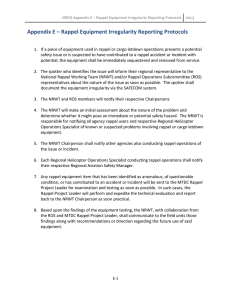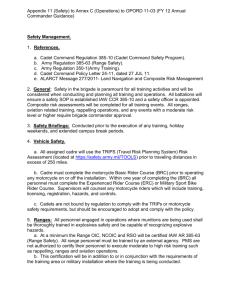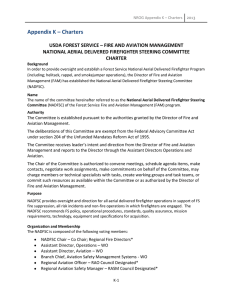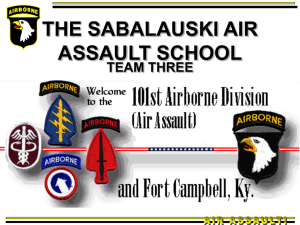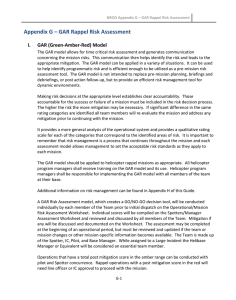National Rappel Program Reactivation Process
advertisement
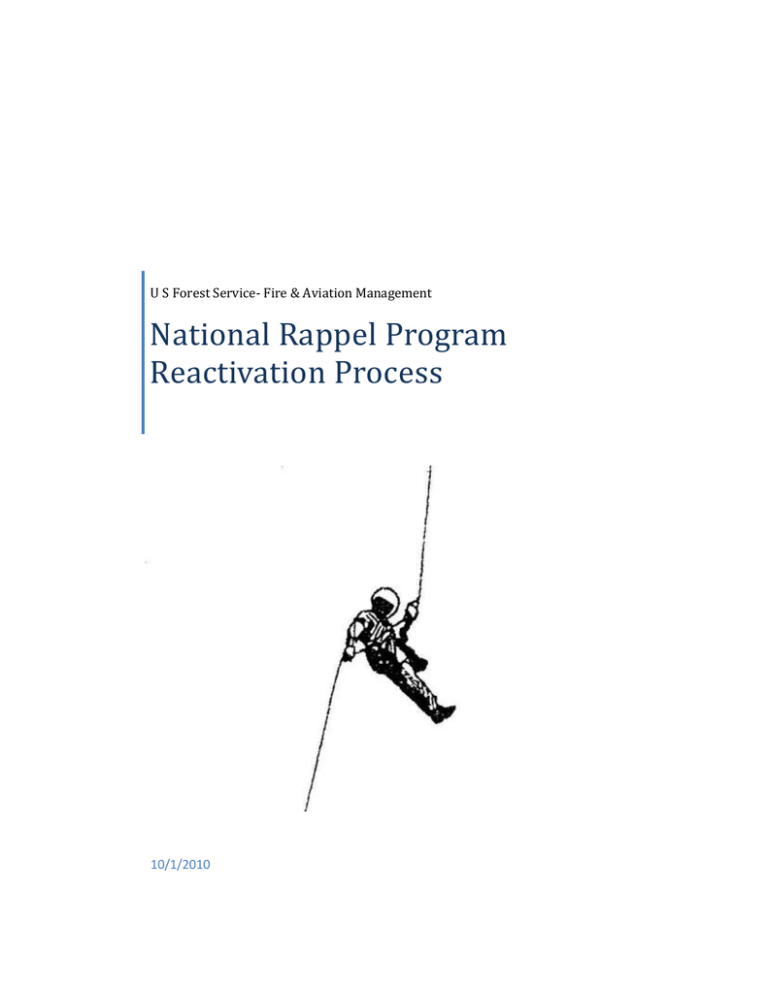
U S Forest Service- Fire & Aviation Management National Rappel Program Reactivation Process 10/1/2010 National Rappel Program Reactivation Process Table of Contents Introduction Rappel Program Update Interagency Helicopter Rappel Guide Quality Assurance in 2010 Future Rappel Plans and Equipment 1.0 National Rappel Program – Leader’s Intent 1.1 Purpose 1.2 Mission Statement 1.3 The Director of Fire and Aviation Management Leaders Intent 1.4 Authority 1.5 General Policy 2.0 Aviation Organization 2.1 National Organization Requirements 2.2 Regional Organizational Requirements 2.3 Forest Aviation Staff 3.0 Administrative Direction 3.1 General 3.2 Reporting and Documentation Requirements 3.3 Regional Rappel Reactivation Request 3.4 Rappel Base Operations Plans 3.5 Quality Assurance In-Brief Package Requirements 3.6 Budget 3.7 Rappel Operations Quality Assurance Review 4.0 Reactivation Process 4.1 General 4.2 Consolidated Rappel Training 4.2.1 Helicopter Rappel Training, July 11, 2007 Letter 4.2.2 National Rappel Training Cadre 4.3 National Rappel Reactivation QA Team Planning 4.4 Documentation 4.5 Train the Trainer 4.6 Crew Resource Management Training 2 4.7 Crew Span of Control 5.0 Best Practices 5.1 General 5.2 Rappel Academy 5.3 Regional MOU 5.4 Regional Rappel Working Group 5.5 Spotter Emersion Training 5.6 Use of the SAFECOM System for Reporting 5.7 Aviation Operational Risk Management 5.8 Use of Aviation Safety Technical Assistance Teams Appendix A – Official Correspondence • 2007 Letter from Deputy Chief Hubbard that provides direction from the recommendations in the Feasibility of Conducting a Competitive Sourcing Competition on Aviation Activities in the U.S. Forest Service • 2010 (February 1) Programmatic Helicopter Rappel Stand-Down Letter Directed by Chief Tidwell • 2010 (June 28) Reinstituting Helicopter Rappel Program Requirement Letter from Deputy Chief's Hubbard and Myers • 2010 (June 28) Reinitiating the Rappel Program Decision Memo from Deputy Chief Hubbard • Letter approving the 2010 Helicopter Rappel Guide by the Director FAM Harbour • National Rappel Reactivation Concurrence Letter from Director FAM Harbour • National Rappel Program Update Letter from the Director Fire & Aviation Management Deputy Chief, State and Private Forestry, James Hubbard 10/18/2010 Appendix B National Rappel Program - Quality Assurance Checklist and Region Action Plan Appendix C National Rappel QA Team – Reactivation Checklist Appendix D Rappel Training Agenda (Example) Appendix E National Rappel Operations Review Checklist v2.1 Appendix F 3 Region Local Unit Rappel Memorandum of Understanding (Example) Appendix G Spotter Emersion Student Workbook (Example) Appendix H Aviation Operational Risk Management Worksheet v8.1 Appendix I Reactivation Request Documentation Checklist Appendix J Interagency Helicopter Rappel Guide (IHRG) Forest Service Edition #1, July 2010 Appendix K Programmatic Risk Assessment and Quality Assurance Evaluation For Helicopter Rappelling – Final Report, March 2, 2010 4 Introduction The reactivation of the National Rappel Program will be a dynamic process. Lessons Learned will be applied during and after each Quality Assurance (QA) Review. Best Practices will be identified that would benefit the rappel program. The Quality Assurance process and documents may be modified to incorporate the lessons learned and best practices. Rappel Program Update On June 28, 2010 a decision memorandum was signed by Deputy Chief for State and Private Forestry James Hubbard (http://www.fs.fed.us/fire/av_safety/assurance/Nat_Rapp/index.html) to re-initiate a partial stand-up of the Forest Service National Rappel Program. Three options were suggested and Option # 2 was approved using the Bell Medium Helicopter as the approved platform. The following is as written in the memorandum for Option #2: Stand up a piece of the program for purposes of program integrity, and maintaining capability for IA in steep terrain, high winds, and big timber. This option will maintain an enhanced medivac capability by providing for insertion of paramedics & EMTs, and provide enhanced helispot construction capability for purposes of extracting injured employees. Additionally, operational capability is needed to test a new rappel descent system currently under evaluation by Missoula Technology and Development Center. Resuming rappel operations with a smaller number of crews/helicopters is a viable strategy for standardizing and strengthening the program (reduce the program to a core size and rebuild based upon those aspects that have proved successful - consolidated training, larger crews, one standard platform, etc.). The Pacific Northwest (PNW) Region is currently the only region to request a reactivation of the rappel program. A National Rappel Quality Assurance Team (QA Team) was convened to ensure compliance with the recommendations from the Willow Helibase Accident Review Board (ARB), the Rappel Risk Assessment Action Plan, and to ensure standardization with the Interagency Helicopter Rappel Guide. Quality Assurance evaluates for compliance to existing policy and standards; effectiveness of the policy and standards for use; and suitability of the policy and standards in achieving Forest Service goals. The QA Team consisted of eleven participants which included the following: Acting Assistant Director, Aviation; Assistant Director, Aviation; Branch Chief, Aviation Risk Management & Training, National Helicopter Operations Specialist, National Aviation Training Specialist, two Regional Helicopter Operation Specialists (R2 & R5), Aviation Management Specialist (R3), Aviation Maintenance Inspector (R4), Helicopter Inspector Pilot (R5), and Missoula Technology Development Center (MTDC) Project Leader. 5 The QA Team worked from the Programmatic Risk Assessment and Quality Assurance Evaluation for Helicopter Rappelling Final Report to develop QA Action Plans for both the Region and the National office. The Region addressed the hazards/mitigations that were Regional in scope and completed the National Rappel QA Team – Reactivation Checklist (Appendix C). The QA Team addressed the hazards/mitigations that were national in scope and recommended that the PNW portion of the National Rappel Program be reactivated. Tom Harbour, Director of Fire & Aviation Management concurred (http://www.fs.fed.us/fire/av_safety/assurance/Nat_Rapp/index.html) Interagency Helicopter Rappel Guide Since August of 2009, the Interagency Helicopter Rappel Working Group (IHRWG), the Interagency Helicopter Rappel Equipment and Procedures Committee and a Sub Working Group consisting of Subject Matter Expert (SME) Check Spotters from each rappelling region and the Department of Interior (DOI) have been working to standardize every aspect of rappelling. Through the efforts of these groups a draft guide has been developed. In order to reactivate the Forest Service’s rappel program an approved Interagency Helicopter Rappel Guide (IHRG) was required. The IHRG, Forest Service Edition 1, July 2010 was approved by Tom Harbour by letter. The Forest Service’s interagency partners have been briefed on the intent of creating a Forest Service Edition and that the FS is committed to a future interagency approved IHRG. Work will resume later this year with the IHRWG to complete the IHRG. Quality Assurance Reactivation A National Rappel Quality Assurance Team (QA Team) will be staffed to provide the QA review of regions requesting reactivation of rappel. The QA Team will evaluate regional rappel training, equipment, aircraft, operational procedures, documentation, staffing and qualifications for compliance with existing agency aviation policy and procedures including the IHRG, risk assessments and QA checklists. Rappel QA Operations Review QA oversight of the National Rappel Program will continue throughout the 2010 season and subsequent years by each Region and a QA Operations Oversight Rappel Review Team consisting of: National Rappel Specialist, National Helicopter Operations Specialist, Regional Helicopter Operations Specialist, Regional Aviation Safety Manager, Helicopter Inspector Pilot and Aviation Maintenance Inspector. The team will evaluate all facets of the rappel program utilizing the National Rappel Operations Review Checklist (Appendix E) meeting the intent of the National standardization effort, adhering to the Interagency Helicopter Rappel Guide (IHRG) and providing a Rappel Quality Assurance Program. These teams will consist of personnel from outside of the region being reviewed. The areas to be evaluated include but are not limited to: • Standard approved equipment is used per the IHRG 6 • • • • • • • • • Inspection, maintenance and care of equipment is performed as outlined in the IHRG Procedures and equipment are consistent with IHRG requirements for rappel and cargo letdown operations Platforms are equipped in a consistent manner per the contract Documentation is completed as required in the IHRG Qualifications (Rappel and Fire) of the personnel follow the IHRG, FSM and FSH policy Seating and configuration are exactly the same as every other base as stated in the IHRG Verbal and hand commands are consistent from base to base per the IHRG Currency and proficiency requirements are complied with per IHRG After Action Reviews (AAR’s) are performed after each operational rappel If for any reason the rappel base being evaluated is not in compliance with the above listed criteria and existing standards, the QA Team may recommend that the rappel base be restricted to helitack operations only until all deficiencies are corrected. A formal follow-up review will be conducted by the National Rappel Specialist to ensure the deficiency(s) has been corrected. Approval to resume rappel operations will be determined by the Director of Fire and Aviation based on recommendations from the Assistant Director, Aviation and the Branch Chief, Aviation Risk Management. The QA Team will provide a detailed report of the findings throughout the season that will assist with making positive changes to ensure the Rappel Quality Assurance Program is progressive, appropriate and consistent with the mission of aerial delivery of personnel via helicopter. This report will be accessible to the field at the end of each calendar year. Future Rappel Plans and Equipment There will be a nationally sponsored programmatic review of the rappel program beginning in the fall of 2010. The National Rappel Programmatic and Needs Assessment Review will evaluate the optimum number of rappel programs, staffing, bases, additional standardization areas and potential types of standardized aircraft. Regions will be integrated into this programmatic review. An Interagency Helicopter Screening and Evaluation Board will be established in FY 2011 to evaluate light helicopters and modern helicopter makes and models. The new equipment being developed by MTDC is still in the process of evaluation. The first phase has been completed which was to build a descent device and test a number of ropes and descent devices from a tower with SMEs. The tower evaluation with the proposed rope and descent device was very successful and showed promise. Some minor modifications were identified that would make the descent device even better. MTDC has been working on these changes and is planning to activate the second phase. This phase will include tower and helicopter rappels. If successful, a third phase will be enacted and will include a training beta 7 test with personnel that have never used the rope and device. If the training beta test is a success there will be a field evaluation for a season. If the equipment passes this evaluation there will be a complete change-over to the new equipment. This evaluation and complete change-over if all goes as planned could happen as soon as 2013, but may take additional time if there are bumps along the way. 8 1.0 National Rappel Program Leader’s Intent 1.1 Purpose The purpose of the Forest Service National Rappel Program Reactivation Plan is to describe National leader’s intent, authorities and roles and responsibilities regarding the National Rappel Program. The rappel reactivation plan also outlines the reactivation process and documentation, and to provide the Regions a clear understanding of the requirements to reactivate the national rappel program in their region. This plan documents standards that the National Rappel Quality Assurance Team evaluates against to reactivate a rappel program and additional requirements. While this document is Forest Service specific, it does incorporate interagency standards. 1.2 Mission Statement The primary mission of the Interagency Helicopter Rappel Program is the consistently safe and efficient aerial delivery of firefighters in support of local, regional, and national firefighting efforts, when appropriate. • • • • • • • Rappellers will be a national shared resource as part of the Forest Service’s National Rappel Program. Rappel training will be consolidated intra-regionally or inter-regionally to maintain national standardization. There will be no more than 1 rappel location/academy per region. Consolidated training will be defined in the National Rappel Reactivation Process 4.2. The National Rappel Program is standardized nationally. All rappel and cargo letdown equipment, operational rappel procedures, helicopters, helicopter configuration, training procedures, training practices and training standards are identical at every base and will conform to the standards. The National Rappel Program will maintain the ability to move rappel resources between geographic areas, to provide an effortless exchange of any rappeller or group of rappellers, their equipment, procedures, and helicopter with any other rappel operation anywhere in the nation and be operational with minimum delay. All rappel bases have the capacity to host booster rappellers and outfit them with firefighting equipment configured in a standard package. A national standardized database will be developed and adopted that that produces efficient and accurate reports and documents rappel equipment use. The number of rappel bases, rappellers and platforms will be determined to meet regional and national needs. 1.3 Director of Fire and Aviation Management Leader’s Intent The Forest Service’s fire and aviation program goal is to provide the aviation tools that safely and efficiently accomplish missions related to the task of managing national forests. The 9 national rappel program is no exception. The Mission Statement and bullets above reflect leader’s intent for the National Rappel Program operations. The Rappel Program requires operational oversight and active management to ensure quality assurance. The proper utilization of aircraft in support of resource management/ protection programs serve as force multiplier when dealing with issues of time, remoteness, terrain, large areas and distances. Aviation management is about balancing mission goals with minimal risk to employees and the public primarily and secondly with the environment and budget. Leader’s intent also includes the following program objectives: Risk Management and Safety • Risk Management and Safety must be core values of our culture, ingrained in the character of every employee. • Provide a safe and healthful environment for all our employees, volunteers, and partners. • Risk management as part of Safety Management Systems (SMS) will be inherent in all aviation missions. • All aviation personnel are empowered and expected to manage the risks of aviation operations and make reasonable and prudent decisions to accomplish the mission. Take every opportunity to plan your missions thoroughly, mindfully balance risks and benefits and respect your aircraft and the environment in which you operate. • Individuals will be held accountable for their decisions, which should be based on policy, principles, risk management, training, experience, and the given situation. • The agency is committed to ensuring our workplaces are free of recognized hazards and, prior to conducting any work project, all risks are mitigated to the lowest acceptable level possible. Professionalism • Personnel performing aviation functions must meet all qualification requirements of the Federal Aviation Regulations, Forest Service Manuals, Handbooks, and Guides. Diversity • Individual development, employee wellness, and workforce diversity will be emphasized at all levels of the Forest Service aviation program. Innovation • With a commitment to aviation risk management and efficiency, managers at all levels are responsible for enhancing the aviation program. 1.4 Authority The authority is enclosed in a Washington Office letter on June 28, 2010, that reactivates the Helicopter Rappel Program as noted in the Chief’s letter dated February 1, 2010, (File Code 10 6730, and “Accident Review Board Safety Action Plan on the Willow Helibase Rappel Accident Fatality”) and the Decision Memorandum approved by Jim Hubbard on June 28, 2010 regarding the reactivation of the national rappel program. The letters can be found in Appendix A and at http://www.fs.fed.us/fire/av_safety/assurance/Nat_Rapp/index.html . 1.5 General Policy The policy that requires employees to follow rappel direction is in FSM 5703 – which references the Interagency Rappel Helicopter Guide. The current version of the IHRG is IHRG, Forest Service Edition 1, July 2010. This document can be found at http://www.fs.fed.us/fire/av_safety/assurance/Nat_Rapp/index.html . 11 2.0 Rappel Organization and Responsiblities 2.1 National Organization Requirements The National Office needs to be staffed to support the national rappel program. The positions required are: • Assistant Director, Aviation • Branch Chief, Airworthiness (National Aviation Maintenance and Logistics Officer) • Branch Chief, Aviation Operations (National Aviation Operations Officer) • Branch Chief, Aviation Risk Management and Training • National Helicopter Operations Specialist • National Rappel Specialist • National Helicopter Standardization Pilot 2.2 Regional Organizational Requirements The Region needs to be staffed to support rappel prior to National Rappel Quality Assurance Team arrival. The positions required are: • Regional Fire Director • Regional Aviation Officer (RAO) • Helicopter Inspector Pilot (HIP) • Helicopter Operations Specialist (HOS) • Regional Aviation Safety Manager (RASM) • Aviation Maintenance Inspector (AMI) • Regional Check Spotter(s) The Region needs to provide documentation that each position is staffed. 2.3 Forest Aviation Staff The Forest needs to be staffed to support rappel prior to Quality Assurance arrival. The positions required are: • Forest Fire Management Officer • Forest Aviation Officer (FAO) • Helicopter Base Manager • Rappel Spotter(s) Each Forest needs to provide documentation that each position is staffed. 12 3.0 Administrative Direction 3.1 General The administration section establishes management responsibilities, policies, and procedures for the administration of the reactivation of the rappel program in each Forest Service Region. 3.2 Reporting and Documentation Requirements The requesting Region is responsible for submitting the documents listed below to request a Quality Assurance Team Review: • Formal request for Regional rappel reactivation from the Regional Fire Director to the Director of Fire and Aviation Management • National Rappel Program - Quality Assurance Checklist Regional Action Plan Completed (Appendix B) • Consolidated Rappel Training Location (approved by Assistant Director, Aviation) • Rappel Training Plan and Agenda • Provide a copy of each Base(s) Helicopter Rappel Operations Plan • Completed Train the Trainer attendee list and a course agenda • Completed Crew Resource Management attendee list • Regional and Forest Fire & Aviation Staffing adequate to support rappel oversight and QA. (A list of aviation positions are listed in Chapter 2.1, 2.2 and 2.3 of this document) • Regional Quality Assurance Plan for operational season 3.3 Regional Rappel Reactivation Request A request to reactivate rappel in a region will include the following at a minimum: • Consolidated training – location and logistical efficiencies. Location(s) would be preapproved. This would have to be negotiated beforehand. • Helicopter availability for QA Team Aviation Maintenance inspection. • Number of bases and rappellers • 2-1 ratio in crew staffing span of control for training, operations and program management. • Regional aviation leadership staffing to support rappel and quality assurance. • Forest aviation leadership staffing to support rappel and quality assurance. • Proposed time-line including the QA review, training and operations. 3.4 Rappel Base Operations Plans Rappel Base Operations Plan shall document the following: • Introduction/ Overview • Organization and Responsibility • Operational Risk Management Process • Helibase Operations • Helicopter Operations 13 • • • • Administrative Procedures Aircraft Accident/ Incident Planning and Processes Supplements including: o Other aircraft operations o Memorandum of Understanding (MOU) o Communication Plans o Helispot/ Helibase Directory o Local Fire Behavior o Local Fire Suppression Standards o Training Plans and Documentation o Crew and Booster Crew Orientation o Tower Operations and Safety o Crew Rotation o AFF Standards Appendices 3.5 Quality Assurance Team In-Brief Package The QA Team will provide an In-Brief package two weeks prior to arrival that will outline the team’s expectations, agenda, and individuals that should be present. 3.6 Funding The Washington Office will incur all of the expenses for the QA Team. 3.7 Rappel Operations Review The national aviation staff in collaboration with regional fire and aviation staff will conduct a QA review of helicopter rappel operations and programs as part of the Rappel Quality Assurance Plan as outlined in the Programmatic Risk Assessment and Quality Assurance Evaluation for Helicopter Rappelling Final Report and Rappel Risk Assessment Action Plan Response. The purpose of the Rappel Operations Review is to ensure that all rappel programs are meeting the intent and standard of the National Rappel Program, abiding by the Interagency Helicopter Rappel Guide (IHRG) and maintaining a Quality Assurance Program. This information will also be utilized to provide a detailed report to the Director of Fire and Aviation Management to ensure the Quality Assurance Program is progressive, appropriate and consistent with the rappel mission. The local rappel programs will be given adequate time, as acknowledged by the Rappel Operations Review Team, to respond to the deficiencies and to identify corrective action planned or already taken. 14 4.0 Reactivation Process 4.1 General Reactivation of a regional component of the National Rappel Program will be a large undertaking and should be planned months in advance. Lessons learned (See Chapter 5 – Best Practices) from previous experience shows planning for consolidated training needs to occur 6 months to a year in advance to accommodate the large number of rappellers logistically in the training location environment. For the initial reactivation (2011 or 2012), a National Rappel Training Cadre will conduct the training at the requesting region’s approved location. The National Rappel Training Cadre will ensure that standardization is consistent across the national rappel program. 4.2 Consolidated Rappel Training The intent of consolidated rappel training is to ensure there is standardization across the individual rappel crews and nationally. Consolidated training can be inter-regional or intraregional. Regions will submit consolidated rappel training locations a minimum of 6 months in advance of the actual training date. The request should include logistical efficiencies, aircraft availability, rappeller numbers, regional aviation leadership staffing to support rappel and quality assurance, etc. Location(s) will be approved by the Assistant Director, Aviation within 14 working days of receipt. See Appendix D for an example of a rappel training agenda. 4.2.1 Helicopter Rappel Training, July 11, 2007 Letter In 2007 the FS conducted a Feasibility Study (Now known as Aviation Activities Management Efficiency Assessment) of its Aviation program. One of the recommendations from the Feasibility Study was to “Consolidate helicopter rappel training to one location in each Region in order to promote standardization and efficiency.” The Deputy Chief, State and Private Forestry signed a letter requesting that regions consolidate rappel training. Regions were to begin planning for consolidated training at that time. The intent of the letter remains valid and is an integral part of standardization. Each region should work with the Assistant Director, Aviation to develop an action plan to meet this requirement. 4.2.2 National Rappel Training Cadre A national rappel training cadre will be organized by the National Rappel Specialist and the Regional Helicopter Operations Specialist from existing qualified rappel check spotters, spotters and other relevant trainers. The requesting regions rappel staff will be integrated into the National Rappel Training Cadre during planning and rappel training. 15 4.3 National Rappel Reactivation QA Team Planning The National Rappel Reactivation QA Team will be organized by the Assistant Director, Aviation. The team will include at a minimum the Assistant Director, Aviation; Branch Chief, Aviation Risk Management; National Helicopter Operations Specialist; National Rappel Specialist; a Regional/National Helicopter Inspector Pilot, Regional/ National Aircraft Maintenance Inspector and a Regional Helicopter Operations Specialist. Other Subject Matter Experts may be included in the QA Team. The team should be organized 30 days prior to attending a regional rappel training academy or comparable session. 4.4 Documentation A requesting region will submit the documents listed in Chapter 3.2 30 days prior to the scheduled Reactivation Quality Assurance review. 4.5 Train the Trainer The Train the Trainer concept was identified in the Rappel Risk Assessment in O1M4 as one means to facilitate standardization in procedures, terminology and instruction. The Train the Trainer Agenda will be documented in a lesson plan reviewed by the National Rappel Training Cadre. A National Train the Trainer agenda is currently being developed. The agenda will include but is not limited to the following: • • • • • • • • • • • • • • 1 Bell Medium Procedures Bell Medium Standardization Points Rappeller Syllabus Training Aids – How many, what kinds, posted or not. New Initial Training Sheets- Pass Fail Identification Points Re-Currency Training Sheets- Decertification Process? Risk Management Model (GAR) Mission Statement Challenge and Response Emergency Procedures Spotter Training Handbook Human Factors-Prescott Accident Review Tower Etiquette Training philosophies – when to introduce miss-rigged (change blindness) equipment with rookies during training. 1 1 If other helicopters are approved for rappelling, procedures and standardization specific to that make and model will be added. 16 4.6 Crew Resource Management Training Crew Resource Management (CRM) training was identified in the Programmatic Risk Assessment and Quality Assurance Evaluation for Helicopter Rappelling Final Report in O4M1 and O4M2. CRM is a means to facilitate standardization in spotter and pilot communication. The CRM training agenda will be documented in a lesson plan reviewed by the National Rappel Training Cadre. The agenda will include but is not limited to the following: • • • • Inspector pilots conduct CRM training with rappel pilots (vendor pilots and relief pilots) and spotters. Rappel mission normal and emergency procedures Challenge and response and scenarios. CRM training includes the Pilot Test Standards and pertinent sections of the Interagency Helicopter Rappel Guide, Forest Service Edition 1 July, 2010. A National Rappel CRM lesson plan is in development. 4.7 Crew Span of Control Crew span of control was identified in the Rappel Risk Assessment in E5M4. The IHRG also addresses span of control in Chapter 2.4.1 – “All Exclusive Use Fire Rappel Modules should maintain a ratio of two fully qualified Rappeller/Helicopter Crewmembers for every Rappeller/Helicopter Crewmember trainee.” Regions shall develop and implement a span of control criteria for training, operations and program management. The 2 – 1 ratio will be implemented during consolidated training. Additional oversight is provided by onsite instructors (spotters and check spotters). Individual crew make-up shall require a 2-to-1 ratio of qualified (HECM/HRAP) to trainee. All rappel flight operations will be configured to meet the 2-to-1 span of control ratio. 17 5.0 Rappel Best Practices 5.1 General In the process of QA review Lessons Learned (LL) and Best Practices (BP) become evident throughout the review. The National QA Team felt these LL and BPs would be very important to document and share with the rappel community. 5.2 Consolidated Rappel Academy Training The Rappel Academy concept has proven to be an excellent means to deliver quality cost effective and standardized training. The academy approach is highly recommended and should be considered by any region planning on reactivation of rappel. Training syllabus, implementation guides and plans are available from the National Rappel Specialist. 5.3 Regional MOU A Memorandum of Understanding (MOU) between the region and the rappel host forest shall be considered prior to requesting a QA review for reactivation. The MOU should provide direction and expectations that accurately outlines the program objectives, mission, administration, and operations for the rappel program hosted by the local forest. The MOU shall be approved by the Regional Fire Director and the local forest line officer(s). See Appendix F for an example. 5.4 Regional Rappel Working Group Establish a Regional Rappel Working Group that mirrors the Interagency Rappel Working Group. Members include regional management representatives and rappel specialists presently involved in the rappel program. The responsibility of the Working Group is to promote standardization, provide quality assurance oversight and exchange ideas and techniques with the entire regional rappel community. The Regional Rappel Working Group would be the conduit to and from the Interagency Rappel Working Group. 5.5 Spotter Emersion Training Spotters can be in limited numbers on occasion due to personnel changes, other fire assignments and other factors that may impede qualifying people to that level. A shortage of spotters may require moving spotters from base to base to provide coverage and maintain rappel capability. A Best Practice is to develop a Spotter Emersion Training curriculum (Appendix G) to ensure that there are adequate spotters available for every operational mission and during training. 5.6 Use of the SAFECOM System for Reporting The Programmatic Risk Assessment and Quality Assurance Evaluation for Helicopter Rappelling Final Report (O2) identified that training rappel mishaps are not reported because 18 there is no avenue to do so. This has prevented information transfer between rappel crews and hampered lessons learned. All rappel mishaps (including ground, training and operational) shall be reported through the SAFECOM system until there is another approved process. 5.7 Aviation Operational Risk Management Forest Service policy (FSM 5720.3, 5704.61 and FSH 5709.16 03) requires “a risk assessment prior to any aviation mission”. Utilizing the Aviation Operational Risk Management worksheet (Appendix H) will meet this policy requirement for all aviation missions. The Aviation ORM may be a combination of Time Critical and Deliberate risk assessment depending on planning time. • The primary purpose of the Aviation ORM Work Sheet is to initiate and stimulate dialogue between aviation managers and users. • The AORM provides a simple means to assess risk and document risk decisions 5.8 Use of Aviation Safety Technical Assistance Teams (STAT) Use the guidance and procedures in the Interagency Fire Operations Handbook (Red Book) Chapter 16-6 to initiate, provide direction to, document and utilize an aviation STAT. STAT teams can provide additional quality assurance and audit oversight during active fire periods. Specific to rappel, STAT may need additional in-briefing, specialized team members (Check Spotter) and documentation. 19 Appendix A • • • • • • • 2007 Letter from Deputy Chief Hubbard that provides direction from the recommendations in the Feasibility of Conducting a Competitive Sourcing Competition on Aviation Activities in the U.S. Forest Service 2010 (February 1) Programmatic Helicopter Rappel Stand-Down Letter Directed by Chief Tidwell 2010 (June 28) Reinstituting Helicopter Rappel Program Requirement Letter from Deputy Chief's Hubbard and Myers 2010 (June 28) Reinitiating the Rappel Program Decision Memo from Deputy Chief Hubbard Letter approving the 2010 Helicopter Rappel Guide by the Director FAM Harbour National Rappel Reactivation Concurrence Letter from Director FAM Harbour National Rappel Program Update Letter from the Director Fire & Aviation Management Deputy Chief, State and Private Forestry, James Hubbard 10/18/2010 Appendix B National Rappel Program - Quality Assurance Checklist and Region Action Plan Appendix C National Rappel QA Team – Reactivation Checklist Appendix D Rappel Training Agenda (Example) Appendix E National Rappel Operations Review Checklist v2.1 Appendix F Region Local Unit Rappel MOU (Example) Appendix G Spotter Emersion Student Workbook (Example) Appendix H Aviation Operational Risk Management Worksheet v8.1 20 Appendix I Reactivation Request Documentation Checklist Appendix J Interagency Helicopter Rappel Guide (IHRG) Forest Service Edition #1, July 2010 Appendix K Programmatic Risk Assessment and Quality Assurance Evaluation For Helicopter Rappelling – Final Report, March 2, 2010 21
